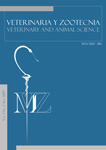Authors
Abstract
ABSTRACT: In order to evaluate the antioxidant capacity of seminal plasma and blood in boars, 20 healthy males were randomly selected in two commercial swine farms, fed with commercial balanced diets. An ejaculate was obtained using the gloved-hand technique, and a 10 mL sample of blood was taken with EDTA. The activity of Glutathione peroxidase (GSH-Px; EC 1.11.1.9) and Superoxide dismutase (SOD; EC 1.15.1.1) in seminal plasma and blood was determined, as well as analyzing the seminal characteristics (volume, mass motility, individual motility, spermatic concentration); a hypoosmotic test (150 mOsm) was carried out. The mean GSH-Px activity was 25.3 ± 12.4 U/mL and 523 ± 106 U/g Hb for seminal plasma and blood, respectively. The SOD activity was 2.1 ± 1.8 U/mL in seminal plasma and 1005 ± 490 U/g Hb in blood. No correlation was found between the activity of the enzymes in seminal plasma and the activity in blood (P>0.05). The lack of correlation between the enzymatic activities in both systems suggests that the two antioxidant systems are independent.
Keywords
References
Aitken, R.J.; Buckingham, D.; Harkiss, D. Use of a xanthine oxidase oxidant generating system to investigate the cytotoxic effects of reactive oxygen species on human spermatozoa. Journal of Reproduction and Fertility, 97: 441-450, 1993.
Aitken, R.J.; Fisher. H. Reactive Oxygen Species Generation and Human Spermatozoa: The Balance of Benefit and Risk. BioEssays, 16: 259- 267, 1994.
Álvarez, J.G.; Touchstone, J.C.; Blasco, L. et al. Spontaneous lipid peroxidation and production of hydrogen peroxide and superoxide in human spermatozoa. Superoxide dismutase as major enzyme protectant against oxygen toxicity. Journal of Andrology, 8(5): 338-48, 1987.
Ceballos, A.; Wittwer, F.G. Metabolismo del Se en rumiantes. Archivos de Medicina Veterinaria, 28 (2): 5-18, 1996.
Comhaire, F.H.; Mahmoud, A.M.; Depuydt, C.E. et al. Mechanisms and effects of male genital tract infection on sperm quality and fertilizing potential: the andrologist’s viewpoint. Human Reproduction Fpdate, 5: 393-8. 1999.
Gavella, M.; Lipovac, V.; Vucic, M. et al. Superoxide anion scavenging capacity of human seminal plasma. International Journal of. Andrology, 19: 82-90, 1996.
Griveau, J.F.; Dumont, E.; Renard, P.J. et al. Reactive oxygen species, lipid peroxidation and enzymatic defence system in human spermatozoa. Journal of Reproduction and Fertility, 103: 17-26, 1995.
Grupo Técnico Kubus S.A. Manual de Inseminación Arti£cial Porcina. Madrid, España: Mar-Car S.A., 1993.
Hansen, J.C.; Deguchi, Y. Selenium and fertility in animals and man: a review. Acta Veterinaria Scandinavica, 37: 19-30, 1996.
Kodama, H.; Yamaguchi, R.; Fukuda, J. et al. Increased oxidative deoxyribonucleic acid damage in the spermatozoa of infertile male patients. Fertility and Sterility, 68: 519-24, 1997.
Kolodziej, A.; Jacyno, E. Effect of dietary selenium and vitamin e supplementation on reproductive performance of young boars. Electronic Journal of Polish Agricultural Fniversities, Animal Husbandry. 7(1), 2004.
Lasota, B.; Baszczyk, B.; Seremak, B. et al. Selenium Status and GSH -Px Activity in Semen and Blood of Boars at Different Ages Used for Artificial Insemination. Reproduction in Domestic Animals, 39: 309-314, 2004.
Lopes, S; Jurisicova, A.; Sun, J.G. et al. Reactive oxygen species: potential cause for DNA fragmentation in human spermatozoa. Human Reproduction, 13: 896-900, 1998.
Mahan, D.C.; Parrett, N.A. Evaluating the efficacy of selenium-enriched yeast and sodium selenite on tissue selenium retention and serum glutathione peroxidase activity in grower and finisher swine. Journal of Animal Science, 74: 2967-2974, 1996.
Man’kovs’ka, I.M.; Serebrovs’ka, Z.O. The role of oxygen radicals in the physiology and pathology of human sperm. Fiziolohichnyi. Zhurnal. 44: 118-25, 1998.
Marín-Guzmán, J.; Mahan, D. C.; Chung, Y.K. et al. Effects of dietary selenium and vitamin e on boar performance and tissue responses, semen quality, and subsequent fertilization rates in mature gilts. Journal of Animal Science, 75: 2994-3003, 1997.
Sánchez, R. Estrés oxidativo y fertilidad. In: Estrés oxidativo y antioxidantes en la salud y nutrición animal. Curso seminario. Valdivia, Chile. 1997. pp 47.
Vallejos, S.; López, C.; Schulz, M. et al. Valores de referencia para superóxido dismutasa, glutatión peroxidasa y estado antioxidante total en sangre y plasma seminal humano. In: II Reunión anual sociedad de andrología y gametología de Chile: IV Jornadas internacionales de medicina reproductiva y biología de la reproducción. International Journal of Morphology, 21: 167- 175, 2003.
Vásquez, J.M.; Martínez, E.A.; Martínez, P. et al. Hypoosmotic swelling of boar spermatozoa
compared to other methods for análisis the sperm membrane. Theriogenology 47: 913-922, 1997.
Villa, N.A.; Ceballos, A.; Correa, S. et al. Evaluación del estado antioxidante en plasma seminal de toros brahman (Bos indicus) en pastoreo y suplementados. Revista Colombiana de Ciencias Pecuarias, 12 (Supl.): 187, 1999.
Zar, J.H. Biostatistical analysis. 4.ed. Prentice Hall. Upper Saddle River, NJ. USA. 1999.

 PDF (Español)
PDF (Español)
 FLIP
FLIP










